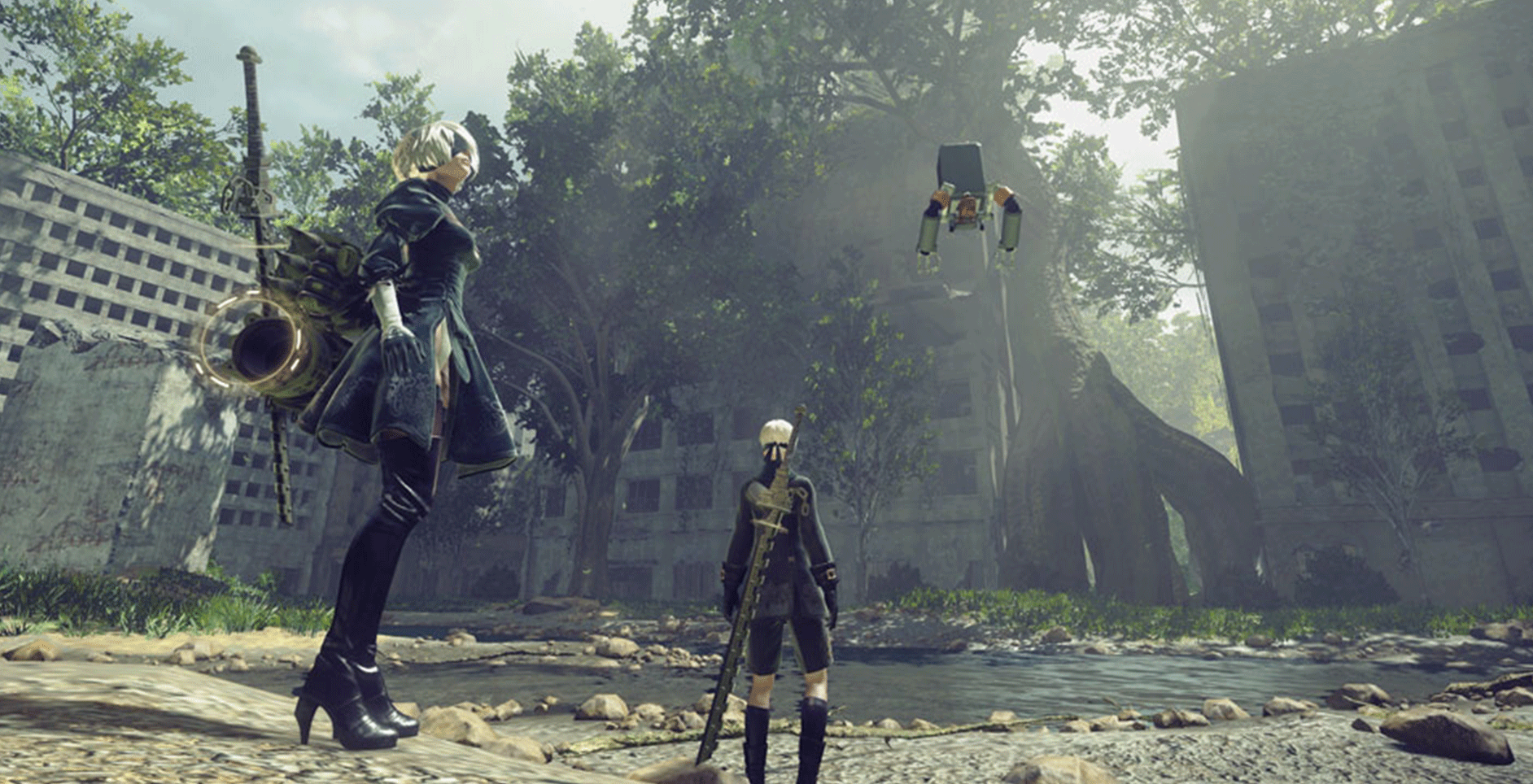On paper, it’s surprising that NieR Automata even exists. The original game didn’t really sell that well and only became a critical darling after its release. Its bizarre concepts didn’t really feel like they would lend themselves well to a sequel. Designed by Yoko Taro, an auteur along the same lines as the greats like Hideo Kojima and Goichi Suda, NieR Automata is a strangely captivating experience that keeps surprising you and almost always has your attention.
For those worrying about whether they must play the original NieR or not to understand Automata, you really don’t. The story takes place years after the original and very little returning characters are here. The story is still as twisted as the first game – creepy machines have forced mankind to flee to the moon, and mankind sends back androids to fight them and claim back Earth. But while the characters of NieR Automata are literally robotic, they’re awesome to watch as they take down the greatest of enemies with aplomb.
 NieR Automata’s story is told in an incredibly unorthodox manner, much like the original game. During my time with the game I could unlock three of the many possible endings. It sounds strange for a game today to almost demand repeat playthroughs to get the full picture, but the twisted and warped tale that Yoko Taro wants to tell works regardless of what approach you take. It’s sufficient to play it through once but almost integral to finish it multiple times as more and more layers of the story are peeled back.
NieR Automata’s story is told in an incredibly unorthodox manner, much like the original game. During my time with the game I could unlock three of the many possible endings. It sounds strange for a game today to almost demand repeat playthroughs to get the full picture, but the twisted and warped tale that Yoko Taro wants to tell works regardless of what approach you take. It’s sufficient to play it through once but almost integral to finish it multiple times as more and more layers of the story are peeled back.
Like the original game, NieR Automata is a semi open world experience not too unlike games like the original Darksiders and Zelda. You play as 2B, one of the androids, who can be equipped with a myriad of deadly weapons to do her bidding. Taking a kind of “kitchen sink” approach, NieR Automata has the best mechanics of an action game, mixed with the best bits of a sidescroller, mixed with the freedom of an open world game with the general design of a Japanese RPG. There’s main quests and side quests, each with their own storylines to complete and a slew of endings, as mentioned previously.
 But the crux of the experience is combat and that’s where the PlatinumGames expertise has largely been harnessed, and very well at that. Your character has a light and a heavy attack, and each weapon can be equipped as such to create a large variety of combos. Each android also has a pod which acts as a projectile weapon – which can be customised to fire bullets, summon shields, conjure heavier weapons like hammers or launch volleys of missiles. Much like Devil May Cry, Bayonetta and Metal Gear Rising before it – the combat is smooth and offers a fantastic variety of options to take down your enemies.
But the crux of the experience is combat and that’s where the PlatinumGames expertise has largely been harnessed, and very well at that. Your character has a light and a heavy attack, and each weapon can be equipped as such to create a large variety of combos. Each android also has a pod which acts as a projectile weapon – which can be customised to fire bullets, summon shields, conjure heavier weapons like hammers or launch volleys of missiles. Much like Devil May Cry, Bayonetta and Metal Gear Rising before it – the combat is smooth and offers a fantastic variety of options to take down your enemies.
You’ll slowly play NieR and realise there’s better ways to approach certain enemies, though this doesn’t matter nearly anywhere as much as it would in any other action game. I’m not quite saying that NieR: Automata is an easy game, but it feels like a much more lenient game when compared to PlatinumGame’s extensive repertoire. Perhaps it’s due to the lack of a ranking system (which is quite frankly relaxing) or the lenient (yet awesome) evasion system. But NieR Automata, even on the higher difficulties, didn’t feel particularly challenging to me. Satisfying? Definitely. Just not anywhere near as difficult as some of the other action games on the market.

Besides weapons and your pods, your android can be customised with chipsets that can be plugged into a motherboard of sorts. Each chip will take up a certain number of slots – so a HP Increase Chip might take up 2 slots while one that improves attack power might take up 5. Such a system allows you to literally build your android the way you want to – making them a powerhouse who might just so happen to prioritise attack power over health (perfect for those who rarely get hit). Others might build their android to have high defense and high HP, dedicating slots that could otherwise be used to improve attack power.
It sounds cliché, but chips are a fantastic way to really curb the difficulty for players who might struggled with NieR: Automata, and feel like a great way to eschew the traditional level up system. There is still a level up system, but the chip system means you don’t necessarily have to grind to improve your stats. Weapons and pods can also be upgraded using salvage from enemies and funds – giving players a wealth of customisation options for their character.

In terms of presentation, NieR: Automata is a fantastic looking game though several concessions have clearly been made to get the game running at an impressively constant 60 frames per second. The open world is vast but bare at times, though traversing it is usually not a problem given how fast everything moves. There will be times where you’ll probably get frustrated as your character could easily fit through a slot the game’s world, but it’s an invisible wall. But generally speaking, the game runs fantastically.
The atmosphere is both foreboding and melancholy too, achieved through a very strong mix of great artistic direction and a unique and yet haunting score. Fans of the original will be surprised to find that, despite such a futuristic setting, the industrial vibe of the original game is still intact and more affective in Automata.
CONCLUSION
Despite its issues, NieR: Automata is a game that we rarely have the privilege of experiencing. Auteur designer Yoko Taro successfully blends his oddball knack for storytelling, defying typical video game conventions in doing so. This leads to a truly unforgettable story, but the way in which it’s told and demands repeat playthroughs is bound to be lost on some part of NieR: Automata’s audience. Regardless, NieR: Automata blends strong action and RPG components into an atmosphere and game that’s well worth experiencing.
The PS4 version of this game was played for the purpose of this review. You can read our review policy HERE.



